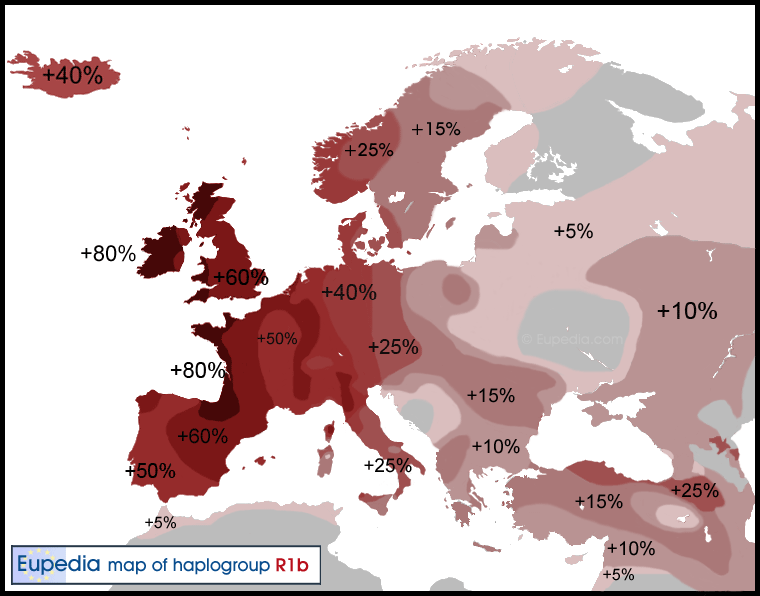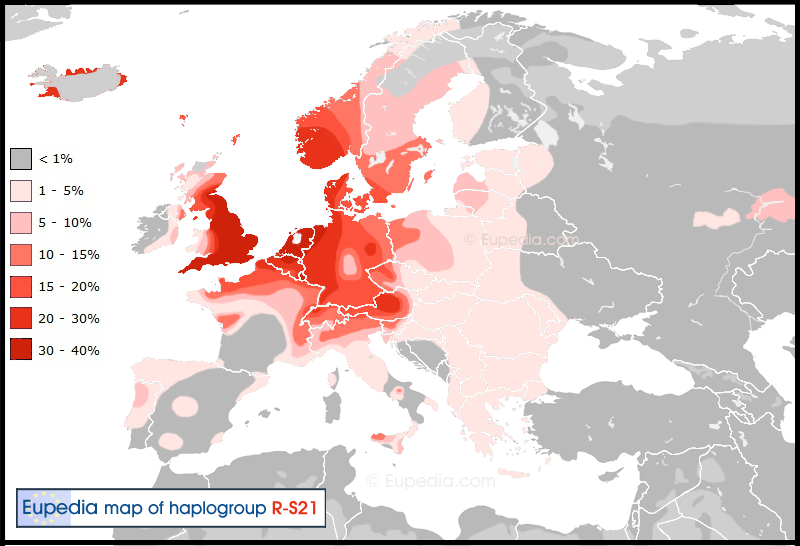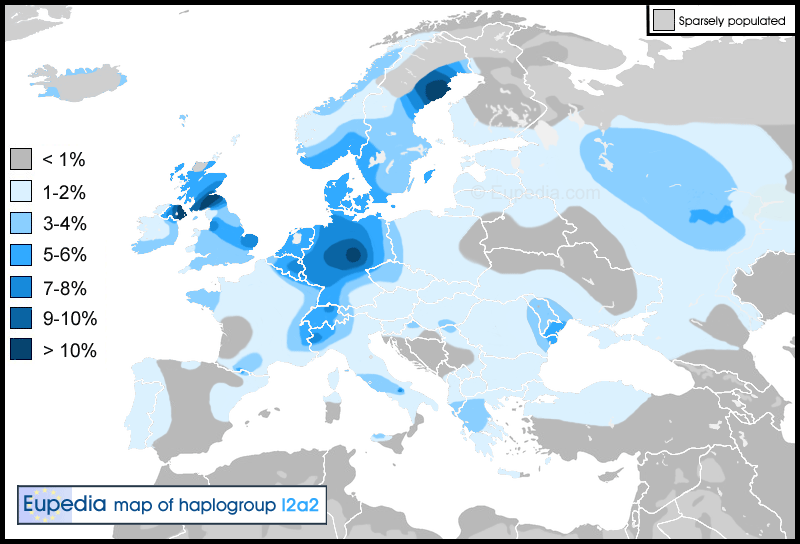Fire Haired
Regular Member
- Messages
- 689
- Reaction score
- 32
- Points
- 0
- Ethnic group
- Celto-Germanic, Latino(~6%)
- Y-DNA haplogroup
- R1b Df27(Spain)
- mtDNA haplogroup
- U5b2a2(Prussia)
This shows all R1b in Europe. I am talking specifically about Germanic Italo Celtic R1b1a2a1a L11. Which would show much more of a connection with distribution of red hair areas with 1% or more.


I have been thinking this for a few months did the R1b1a2a1a Germanic Italo Celts who arrived in west Europe 5,000ybp spread red hair. I described how i think Germanic Italo Celtic spread acroos western Europe and when on my thread Germanic Italo Celts. I didn't do it perfectly i did not explain the different cultures and stuff like that. Or go into detail about about the people. But i gave a basic idea of how and when they spread and in what cultures which FTDNA R1b page says the same(click here). Some criticized me for being to romantic or Patriotic about them and saying their connected with red hair i was just trying to make it exciting and i am not being biased about this. I defintley don't think they are the original source of red hair. U can see in my thread Origin of red hair. Red hair exists in Samartians who have no traces of European in globe13 test. Also red hair exists in Urlaic Udmurts in volga Russia at 10-15% as high or hogher than anywhere in western Europe. Also red hair was pretty popular in proto Indo iranian speakers in northern Russia. Red hair exists throughout Europe but is extremely rare i think it originated in the mid east 60,000-80,000ybp but first went over 1% in Russia 12,000-20,000ybp.
If it is true red hair was brought over 1% in west Europe by Germanic Italo Celts this would mean a huge portion of western Europeans ancestry is from proto Germanic Italo Celtic speakers. Heavily red haired people like in the British isles might mainly descend from Germanic Italo Celts not native western Europeans. The dissertation of red hair maps that show only areas with 1% or more almost perfectly matches the map of R1b in Europe but really comes from subclade R1b1a2a1a L11. It seriously borders the R1b1a2a1a L11 Germanic Italo Celtic world and the rest of Europe. There is 1-3% in areas of Poland which had alot of Gothic and Vandal settlement and Germanic R1b1a2a1a1 S21. also southern Croatia which had alot of Italo Celtic Urnfield settlement and a pretty good amount of Italo Celtic R1b1a2a1a2 S116.
I am for sure that red hair was brought up over 1% n Scandinavia by the spread of Germanic speakers who migrated out of central Europe and arrived in southern southern Scandinavia 4,000ybp and started Nordic bronze age culture. Here is how i know the connection with the distribution of pre Celtic pre Germanic I2a2 in Scandinavia which matches the distributions of Germanic R1b1a2a1a1 s21 and red hair at 1% or more.



To me it is pretty obvious Germanic speakers spread red hair to Scandinavia or at least raised it to 1% or more. Why couldn't Italo Celts done the same in western Europe. The Gedorsian in K12b test shows total connection with R1b in Europe which is almost all under R1b1a2a L23. The British isles in western Europe has the highest they also have the highest R1b1a2a1a L11 and red hair so maybe most ancestry from proto Germanic Italo Celts i made that argument in this thread(British almost all ancestry from Celtic and Germanic invaders). Germanic Italo Celtic R1b1a2a1a L11 grandfather R1b1a2a L23 would have come out of the north mid east or at least its great great grandfather or whatever at some point 6,000-10,00ybp it arrived in southeast Europe or southern Russia. So the high amount of red hair would be from the maternal side and Europeans in one of those areas they inter married with i wonder if somehow deep mtDNa subclades cane trace it.
Since red hair is so much under the borders of heavily R1b1a2a1a L1 and Germanic Italo Celtic speaking areas it is obvious to me there is no way this is from the Neolithic western Europeans. The borders and everything is just to much evidence for me i cant really think of any other explanations than Germanic Italo Celts. Click here this project excepts to get pigmentation genes from Bronze age Corded ware people in central and northern Europe from about 3,000bc(5,000ybp). I except no red hair all brown and blonde like people in Poland and most in Baltic area today. But if they get Pigmentation from Bell beaker people or another people in central Europe from 5,000ybp like the R1b samples from Bell Beaker. I except at least some red hair it might prove this idea. I except that if they test for it they might find from 100 Y DNA samples a almost only R1b1a2a1a L11 people with over 10 having red hair maybe 20. and the surrounding non R1b1a2a1a L11 people will have all Brown and blonde which would be huge evidence for this i guess theory. The proto Germanic Italo Celtic speakers i think had around 20% red hair.


I have been thinking this for a few months did the R1b1a2a1a Germanic Italo Celts who arrived in west Europe 5,000ybp spread red hair. I described how i think Germanic Italo Celtic spread acroos western Europe and when on my thread Germanic Italo Celts. I didn't do it perfectly i did not explain the different cultures and stuff like that. Or go into detail about about the people. But i gave a basic idea of how and when they spread and in what cultures which FTDNA R1b page says the same(click here). Some criticized me for being to romantic or Patriotic about them and saying their connected with red hair i was just trying to make it exciting and i am not being biased about this. I defintley don't think they are the original source of red hair. U can see in my thread Origin of red hair. Red hair exists in Samartians who have no traces of European in globe13 test. Also red hair exists in Urlaic Udmurts in volga Russia at 10-15% as high or hogher than anywhere in western Europe. Also red hair was pretty popular in proto Indo iranian speakers in northern Russia. Red hair exists throughout Europe but is extremely rare i think it originated in the mid east 60,000-80,000ybp but first went over 1% in Russia 12,000-20,000ybp.
If it is true red hair was brought over 1% in west Europe by Germanic Italo Celts this would mean a huge portion of western Europeans ancestry is from proto Germanic Italo Celtic speakers. Heavily red haired people like in the British isles might mainly descend from Germanic Italo Celts not native western Europeans. The dissertation of red hair maps that show only areas with 1% or more almost perfectly matches the map of R1b in Europe but really comes from subclade R1b1a2a1a L11. It seriously borders the R1b1a2a1a L11 Germanic Italo Celtic world and the rest of Europe. There is 1-3% in areas of Poland which had alot of Gothic and Vandal settlement and Germanic R1b1a2a1a1 S21. also southern Croatia which had alot of Italo Celtic Urnfield settlement and a pretty good amount of Italo Celtic R1b1a2a1a2 S116.
I am for sure that red hair was brought up over 1% n Scandinavia by the spread of Germanic speakers who migrated out of central Europe and arrived in southern southern Scandinavia 4,000ybp and started Nordic bronze age culture. Here is how i know the connection with the distribution of pre Celtic pre Germanic I2a2 in Scandinavia which matches the distributions of Germanic R1b1a2a1a1 s21 and red hair at 1% or more.



To me it is pretty obvious Germanic speakers spread red hair to Scandinavia or at least raised it to 1% or more. Why couldn't Italo Celts done the same in western Europe. The Gedorsian in K12b test shows total connection with R1b in Europe which is almost all under R1b1a2a L23. The British isles in western Europe has the highest they also have the highest R1b1a2a1a L11 and red hair so maybe most ancestry from proto Germanic Italo Celts i made that argument in this thread(British almost all ancestry from Celtic and Germanic invaders). Germanic Italo Celtic R1b1a2a1a L11 grandfather R1b1a2a L23 would have come out of the north mid east or at least its great great grandfather or whatever at some point 6,000-10,00ybp it arrived in southeast Europe or southern Russia. So the high amount of red hair would be from the maternal side and Europeans in one of those areas they inter married with i wonder if somehow deep mtDNa subclades cane trace it.
Since red hair is so much under the borders of heavily R1b1a2a1a L1 and Germanic Italo Celtic speaking areas it is obvious to me there is no way this is from the Neolithic western Europeans. The borders and everything is just to much evidence for me i cant really think of any other explanations than Germanic Italo Celts. Click here this project excepts to get pigmentation genes from Bronze age Corded ware people in central and northern Europe from about 3,000bc(5,000ybp). I except no red hair all brown and blonde like people in Poland and most in Baltic area today. But if they get Pigmentation from Bell beaker people or another people in central Europe from 5,000ybp like the R1b samples from Bell Beaker. I except at least some red hair it might prove this idea. I except that if they test for it they might find from 100 Y DNA samples a almost only R1b1a2a1a L11 people with over 10 having red hair maybe 20. and the surrounding non R1b1a2a1a L11 people will have all Brown and blonde which would be huge evidence for this i guess theory. The proto Germanic Italo Celtic speakers i think had around 20% red hair.
Last edited:

